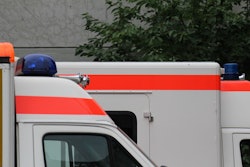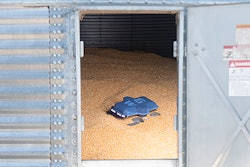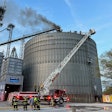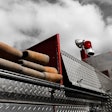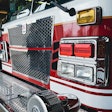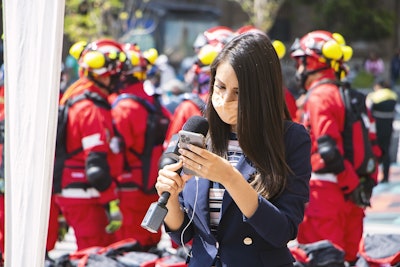
Just last week, an employee of a feed mill in Utah was arrested and a judge ordered he be held without bail after thefeed mill’s manager found a threatening noteon the employee’s desk.
The manager at theIntermountain Farmers Association (IFA)feed mill in Nephi, Utah, found “what looks like a hit list” on an employee’s desk while the employee, Kevin Jerman, 56, was out sick for the day.
The note allegedly described, in detail, weapons, ammunition and instructions on how to “take out” people in various areas of the mill amounting to “14 total kills,” as well as plans to “take a position high up to snipe” if police arrive.
Jerman was arrested March 24 on a felony charge of threat of terrorism.
This situation is thetype of scenariothat keeps many grain facility and feed mill managers up at night. Explosions, workplace shooters, accidents, cyberattacks and financial malfeasance are just a few nightmares that might be keeping you up.
“这不是一个“如果”的问题你有一个危机,这是'when,'"Lani Jordan, Strategic Communication Consultant,says during the "Navigating Your Worst Nightmare: Proactive Crisis Communication Response" education session Tuesday morning atGEAPS Exchange 2022in Kansas City.
"You can't predict the future, but you can plan for it."
One-fourth of small businesses will have a crisis in any given year, and a significant number will never recover, says Jordan.
Here are a few mistakes to avoid: don't create your own crisis; fail to have a responsive culture; fail to have a plan; fail to take things seriously; be unprepared to communicate; and forget to put people first.
What should your emergency action plan consist of?
Every facility should have an emergency action plan in place in case any of the ‘worst case scenarios’ happen to them. One of the first considerations should be who’s on the team?
Typically, team members should consist of company leadership, such as the CEO; environment, health and safety staff; legal members and lawyers; your information security (IT team); insurance representatives; human resources; and your communications team.
The next step is to identify your audience – who are you trying to communicate with?
“Is it your long-standing neighbor? Or is it the local media,” says Jordan. “Each audience will have a slightly different key message you want to deliver depending on the crisis.”
Depending on the crisis, it’s always good to remember that each audience will want to know how the crisis impacts them.
"In difficult times, people worry about how their lives and how their livelihoods will be impacted by the crisis,” says Jordan.
Who is going to speak for you?
Part of your emergency action plan should be who is going to be the designated spokesperson.
“This might change depending on the scenario and the severity of the crisis,” says Jordan.
Look at how significant the event is – is it local and minor? Is it catastrophic? What will be the long-term impact?
“这可能是人to wear multiple hats at your company,” says Jordan. "But whoever it is, he or she must remain calm under duress and know the key message statements."
What is the key message?
Key messages statements are consistent with your facility’s values, behavior and objectives. And must be completely true.
Standby statements adapt key messages to the details of a specific incident or issue and are developed for use as needed. These are also targeted to specific audiences, include specific examples and facts, and incorporate personal experiences
"Key messages are way to get back on offense," says Jordan. "During a crisis or emergency, you want to tell your own story and control the important things you want others to know."
Key messages are a guide for interviews and other engagements.
"Repeat them often in your communications so they resonate with the audience," says Jordan. "The key message should get to the point with one sentence - the what, how and why are in one place.
"Remember key message help you bring you back the conversation back to where you want it to be to get your points across."
Dealing with the media
When there’s a crisis or emergency at your facility, the media will most likely want to know what’s happening. Who's talking to the reporters?
"Designate a spokesperson in advance. Arrange media training and have backups," Jordan says. "Build relationships with your local media in advance."
It’s also a good idea to have a media policy in place.
"Only designated people can speak to the media," she says. "All spokespeople will be prepped. Employees should direct media to queries to designated spokesperson."
Be prepared to say something fast – within 20 minutes of a crisis.
“This is why key messages are important to have and know in advance of a crisis,” says Jordan.
During an emergency, stay calm, remain professional – but remember to demonstrate concern and compassion. "These are people we're talking about,” reminds Jordan.
In today’s world, social media is part of any conversation, for good or bad. News now “breaks” online and in social media and could be the source of your crisis.
“Your crisis might develop or grow on social media,” says Jordan. “Respond in the forum where the story surfaced. During a crisis it’s a must to monitor, monitor, monitor social media and get ahead of any wrong information.
“Unfortunately, you can’t erase or correct inaccurate information once it's out in the social media realm,” she says. "But social media can be a proactive tool to get your message out too."






